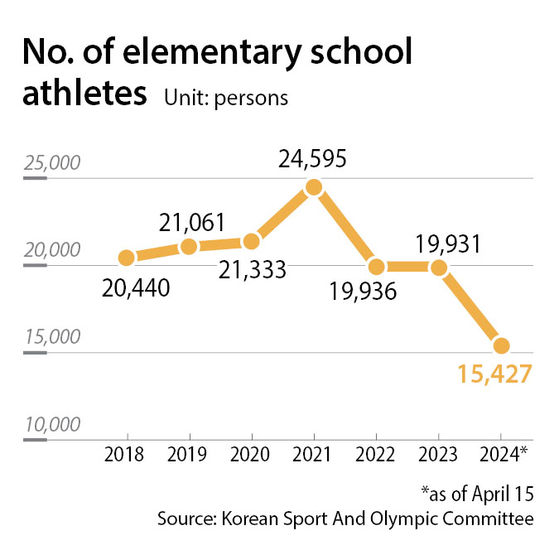Low birthrate leads to fewer young Korean athletes
Published: 18 Apr. 2024, 16:36
Updated: 18 Apr. 2024, 18:37
-

- KIM JI-YE
- kim.jiye@joongang.co.kr
![Aerial view of Paris during the upcoming Paris Olympics with Eiffel tower and Seine river [ATOUT FRANCE]](https://koreajoongangdaily.joins.com/data/photo/2024/04/18/b5c2afe7-6fbd-453d-85fc-c87b990124dc.jpg)
Aerial view of Paris during the upcoming Paris Olympics with Eiffel tower and Seine river [ATOUT FRANCE]
Last year, the team started off with five players. By August, it had none, and fully disbanded a month later.
Due to the low birthrate, the number of elementary school athletes, who are seen as the next generation of Korea's sports future, was halved within three years.
According to the Korean Sport and Olympic Committee (KSOC) on Monday, the number of elementary school athletes peaked in late 2021 at 24,595, but then started to drop to 19,936 players in 2022 and 19,931 last year.
As of Monday, there were 15,427 elementary school athletes, a drastic decrease by some 40 percent in three years.

This is mainly because children born in 2015 and onward started enrolling in elementary schools in 2022.
According to Statistics Korea, the number of newborns steadily decreased since 2015, when there were 438,420 newborns.
This year, the number of newborn babies is expected to come to 229,970 — half of last year's figure.
Some say that the number of elementary school athletes will continue to decrease as the number of newborns continues to decline. Consequentially, athletes in middle and high school will also decrease.
According to the Ministry of Education, the number of elementary, middle and high school athletes shrank to 46,000 athletes last year from 59,000 in 2019.
Due to the decrease in student athletes, school athletic clubs are increasingly disbanding.
The number of schools operating sports clubs fell to 3,890 in 2022, almost a 30 percent decrease from 5,281 in 2012.
The schools that did not disband their athletic clubs are approaching games in creative ways to compensate for lack of players.
For example, Suwon Girls' High School's basketball team had five players as of last August, which is the minimum number required to play basketball.
![The countdown clock is set up in front of the Eiffel Tower by the Seine River, reading 100 days before the Paris 2024 Olympic Games opening ceremony to be held in July. [AP/YONHAP]](https://koreajoongangdaily.joins.com/data/photo/2024/04/18/5794db7b-c673-4d38-8cc4-d40e5db4536b.jpg)
The countdown clock is set up in front of the Eiffel Tower by the Seine River, reading 100 days before the Paris 2024 Olympic Games opening ceremony to be held in July. [AP/YONHAP]
So the team made fouls on purpose.
By intentionally committing five personal fouls, three of the four remaining players disqualified themselves from playing, effectively also disqualifying the team from continuing the game.
Another basketball team from Songeui Girls' High School also used the same method.
The impact of Korea's low birthrate seems to be affecting the national team as well.
Korea is expected to send one of its smallest team of athletes, some 170 participants, for the upcoming Paris 2024 Olympics.
This is the smallest number the country sent in 48 years since the Montreal 1976 Olympics, which had 50 players. Since the Seoul 1988 Olympics, Korea has sent a national team of more than 200 athletes per Olympic Games.
The decrease in the number of athletes will reduce Team Korea's overall performance.
Korea brought home 13 gold medals, a record high, from the Beijing 2008 Summer Olympics. In the London 2012 Summer Olympics, Korea's national team earned the same number of gold medals, but saw decreases in the following Games.
In the Rio 2016 Summer Olympics, the national team won nine gold medals, and the number further decreased to six during the following Tokyo 2020 Summer Olympics.
The KSOC expects Korea to win five to six gold medals at the upcoming Olympic Games this July.
"We may not enter the top 20 during this summer's Olympics," Lee Kee-heung, the president of KSOC, said to the JoongAng Sunday in February. "If Korea is pushed back out of the top 20 list, it will be the first time in 52 years since the Munich 1972 Summer Olympics, when Korea ranked at No. 33."
However, though the number of adolescent athletes is falling, the amount of private education expenses for physical education subjects is rising.
Private education expenses for elementary, middle and high school students reached 3.03 trillion won ($2.2 billion) last year from 1.58 trillion won in 2020, according to Statistics Korea and the Education Ministry's yearly research on private education expenses used for students.
The expenses recorded last year were the highest amount since private education institutions started collecting data in 2007.
"The infrastructure for everyday physical activity for healthy living is expanding," an official from the KSOC's Youth Sports department said. "We must not stop here and continue to discover athletes in order to show improvements in performances such as the Olympic Games."
BY KIM MIN-JOONG, KIM JI-YE [kim.jiye@joongang.co.kr]










with the Korea JoongAng Daily
To write comments, please log in to one of the accounts.
Standards Board Policy (0/250자)